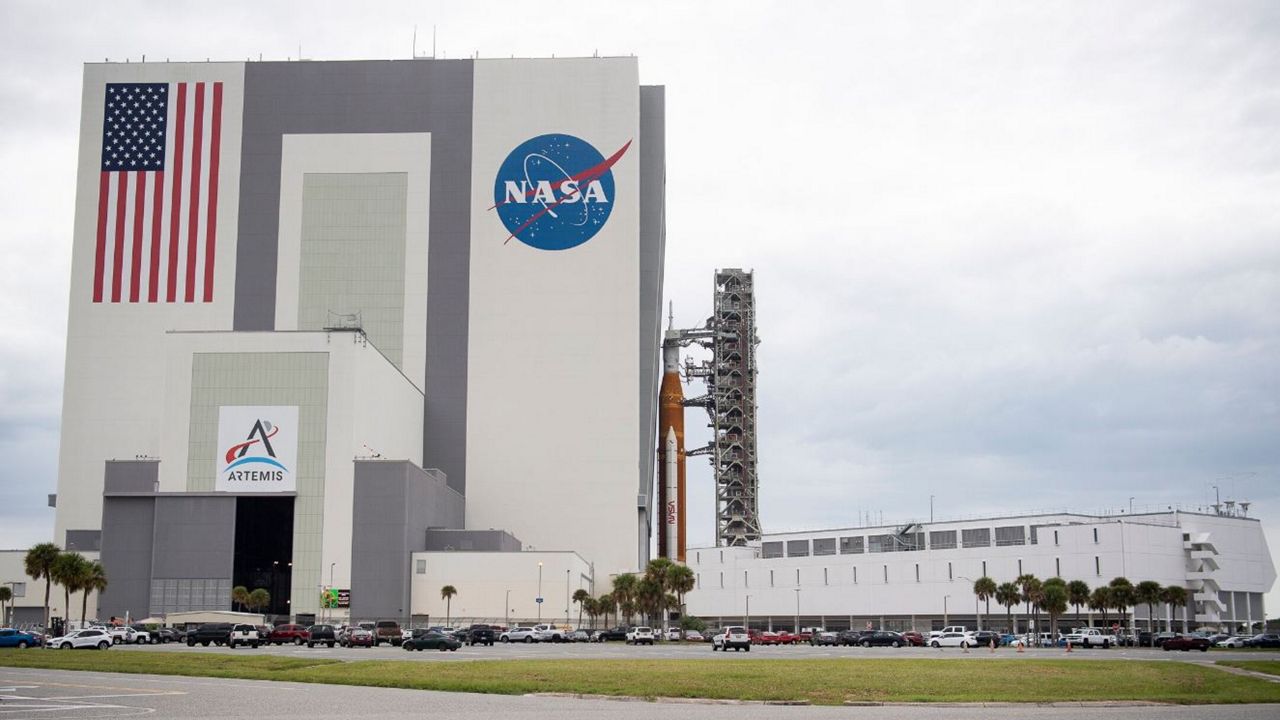KENNEDY SPACE CENTER — It was something that NASA tried not to do, but Hurricane Ian forced its hand: Rolling the Space Launch System rocket back into the Vehicle Assembly Building.
What You Need To Know
- The rollback has been completed is expected to start Monday night
- NASA said Artemis I and the Orion capsule are safely inside the Vehicle Assembly Building
- RELATED coverage: Ian forces NASA to prepare rollback of Artemis moon rocket
The rollback has been completed, and the Artemis I Space Launch System rocket and Orion spacecradt are secured in the VAB.
Ahead of Hurricane Ian, our #Artemis I Moon rocket and spacecraft were rolled back from the pad and secured inside @NASAKennedy's Vehicle Assembly Building. In a teleconference at 2pm ET (18:00 UTC), NASA leadership will discuss the decision to roll back: https://t.co/rn7zVQfhOi https://t.co/a5qd21vM6S
— NASA (@NASA) September 27, 2022
NASA announced on Monday that it would roll back Artemis I and the spacecraft.
The launch team and managers based their decision for the big trip based on the latest weather predictions for Hurricane Ian, with NASA adding, “The time of first motion also is based on the best predicted conditions for rollback to meet weather criteria for the move.”
NASA started moving the gigantic 212-foot-tall rocket and the spacecraft from their home at Launch Pad 39B at the Kennedy Space Center to the Vehicle Assembly Building at 11 p.m. EDT on Monday.
The slow crawl back takes six to 12 hours to make the 4-mile expedition from the pad to the building.
NASA officials said during a teleconference on Friday that predicted wind conditions would need to be 85-mph gusts at the launch pad for NASA to roll back the rocket to the Vehicle Assembly Building. They also said during the actual rollback, sustained winds would have to be less than 40 mph.
Before Ian dampened launch plans, the Eastern Range granted NASA’s request to not have the battery check of the rocket’s flight termination system. If the launch had happened on Tuesday, Sept. 27, as planned, it would have been 42 days since the abort system batteries were last inspected.
Yet, it is anticipated that they would be recharged while inside the Vehicle Assembly Building.
NASA has not confirmed the next launch attempt, but according to the mission availability chart, the next chance that does not conflict with Hurricane Ian or the SpaceX Crew-5 launch is Monday, Oct. 17 through Oct. 31, 2022. Then the next opportunity begins on Nov. 12.
Third time’s not a charm
NASA has tried to launch the uncrewed Artemis I moon mission three times, but has been met with issues.
The first attempt in August saw a liquid hydrogen leak and temperature issues with the engines, which were resolved.
The second attempt, on Sept. 3, saw a different liquid hydrogen leak at the 8-inch quick disconnect line, which is an umbilical that is used to feed the liquid hydrogen from storage tanks into the rocket’s core stage.
NASA replaced two seals where the leak was and a cryogenic demonstration test was conducted on Wednesday, Sept. 21.
However, a different leak was discovered in the same location, yet, engineers were able to manage it and were able to fill up the liquid hydrogen side of the rocket.
During a teleconference call on Friday, NASA officials said they were going to push ahead for the third launch attempt on Tuesday, Sept. 27, saying that they were tracking the system and hoping that it would change course.
Yet on Saturday, after reviewing weather updates, NASA decided to prepare the rocket for a rollback to the Vehicle Assembly Building.
The next launch attempt is scheduled for Sunday, Oct. 2, but NASA has not confirmed if that date is workable.



